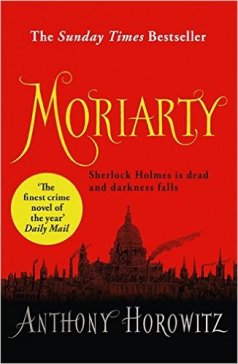
Moriarty by Anthony Horowitz
My rating: ★★★☆☆
(Warning this post contains plot spoilers)
The Basics: A private detective from an American agency, Frederick Chase, arrives in London to investigate the brutal murder of his former coworker in a quiet London suburb. Chase’s investigation, taking place in the immediate aftermath of the death of Sherlock Holmes at the Reichenbach Falls, brings him into contact with the Scotland Yard Inspector, Athelney Jones, a keen student of Holmes’ famous detecting skills. Their pairing leads them into a dangerous investigation into the shady underworld of a new wave of American crime sweeping London.
In depth: Firstly I must admit this book was an impulse buy. Firstly for its title: Moriarty is a character who greatly interests me and this is mainly down to the marvellous depiction by Andrew Scott in the BBC hit series Sherlock. Secondly, the simple but alluring cover art of a Victorian London with St. Pauls Cathedral towering over a smoke filled London skyline.
I was also not aware of the prequel to this novel also by Anthony Horowitz, interestingly the only author to have ever been granted permission by the family of Conan Arthur Doyle to add to the Holmes canon. However, although a novel with a almighty plot twist, which I genuinely did not see coming, I found this book underwhelming and at best rather average.
The narrator, Frederick Chase, arrives in Switzerland at the body of the criminal mastermind Moriarty who had supposedly fell to his death alongside his arch nemesis Holmes at the Reichenbach Falls. Here Chase meets the other main character, Athelney Jones of Scotland Yard, a keen student knowledgeable of the many wondrous ways of the great detective. The pair quickly spark up an investigative relationship which is obviously meant to mirror that of Holmes and Watson.
However the pair’s investigations centre not on the mystery of Moriarty’s and Holmes’ deaths, but on finding an unseen American criminal mastermind, known as Clarence Devereux, who they suspect is attempting to replace Moriarty and make London his own. Although central to the later plot twist, most of the plot actually fills like a second rate version of a Holmes/Watson tale with characters with little backstory and, frankly, of little interest. Even the murder teased at on the back cover of the novel, of a former coworker of Chase’s from the American private investigatory firm, receives scant attention.
The new supervillian Clarence Devereux turns out to be an American disguised as a diplomat hiding behind the jurisdictional protection of the American Embassy in London. His is a character not revealed to late, and of no major interest, and his lesser American criminal allies who make up most of the novel are of even less interest.
To the authors credit there are a number of things this book does well. Horowitz’s Victorian London is a wonderful setting, particularly its dark and dangerous docks in the East End the perfect scene for a number of pursuits by Chase and Jones. There are also one or two familiar characters from the Holmes canon such as Lestrade from Scotland Yard and the choice of Anthenly Jones as a central character is a neat one as he actually appears as a minor character, depicted as a useless policeman, in an original Sherlock story “The Adventure of the Six Napoleons.”
However the characters of Holmes and Moriarty (both said to be dead) or even Dr. Watson are hardly mentioned until a late plot twist. Although no doubt a surprise and logically astute, the book’s narrator Chase is revealed to be Professor Moriarty, who has used Scotland Yard and Jones to find his elusive rival Devereux. The books most interesting passages are when the narrator briefly retells the plot through this new scope, a murder investigated in the book was actually carried out by the narrator. The author then actually candidly challenges the reader as to why this makes sense as the name which adorns the book is of course Moriarty and it should be no surprise that it is his story contained within.
Although undoubtedly clever, this plot twist, as well as the conclusion of the story, which sees Moriarty murder Jones, kidnap Devereux and concludes by deciding to travel back to the USA to take over his criminal network there, are ultimately underwhelming. It may seem harsh but they do not feel worth the slog that is the preceding investigations of second rate American villains by Chase/Jones.
The book is then strangely concluded by a separate short story which does actually in fact centre on Holmes and Watson. This is, I think, unrelated to the preceding story and probably the best part of Horowitz’s strange and underwhelming book. Maybe another sequel with the return of Holmes and Watson in the same universe as Moriarty is in order.
Have you read this book? Do you agree with my review or did you have a different take on it? Do you think that modern authors can productively add to famous old stories? Please your comments below.
